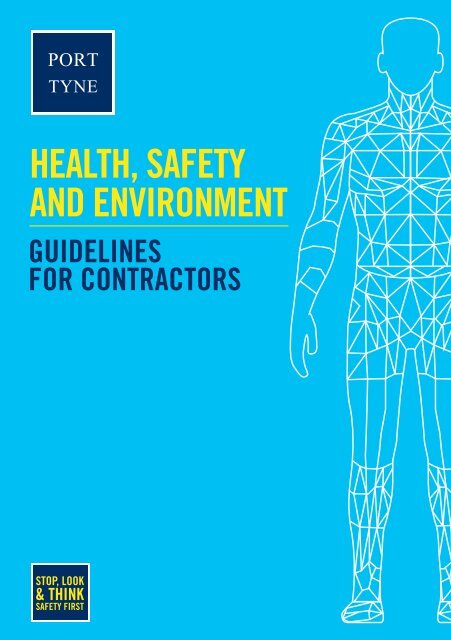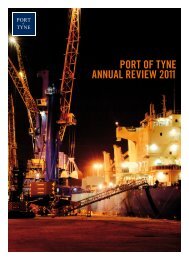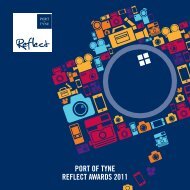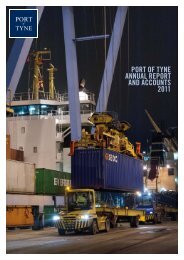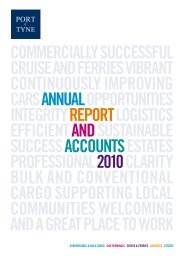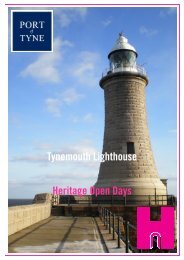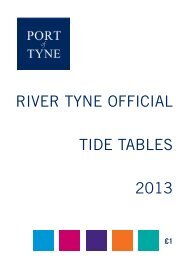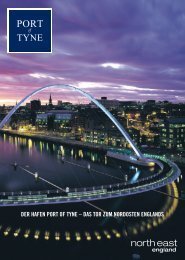Contractor guidelines - Port of Tyne
Contractor guidelines - Port of Tyne
Contractor guidelines - Port of Tyne
Create successful ePaper yourself
Turn your PDF publications into a flip-book with our unique Google optimized e-Paper software.
HEALTH, SAFETY<br />
AND ENVIRONMENT<br />
GUIDELINES<br />
FOR CONTRACTORS<br />
STOP, LOOK<br />
& THINK<br />
SAFETY FIRST
HEALTH, SAFETY AND ENVIRONMENT GUIDELINES FOR CONTRACTORS<br />
CONTENTS<br />
INTRODUCTION 03<br />
NORTH ESTATE SITE PLAN 04<br />
SOUTH ESTATE SITE PLAN 05<br />
KEY SITE GUIDELINES 06<br />
HEALTH AND SAFETY RULES AND REQUIREMENTS 09<br />
ENVIRONMENT RULES AND REQUIREMENTS 12<br />
HEALTH & SAFETY POLICY 14<br />
ENVIRONMENTAL POLICY 15<br />
FIRE PROCEDURE<br />
In the event <strong>of</strong> a fire: First raise the alarm using the nearest break glass point.<br />
Call 999 for Emergency Services then ring 0191 455 2671 to advise Reception/Security.<br />
EMERGENCY PROCEDURE<br />
In the event <strong>of</strong> an emergency: Call 999 for Emergency Services then ring 0191 455 2671<br />
to advise Reception/Security.<br />
In the event <strong>of</strong> a major incident/accident or emergency happening a report must be made<br />
to the <strong>Port</strong> contact responsible for the contract.<br />
02
WWW.PORTOFTYNE.CO.UK<br />
INTRODUCTION<br />
THE PORT OF TYNE IS COMMITTED TO ENSURING THE HEALTH,<br />
SAFETY AND WELFARE OF ITS EMPLOYEES AND ANY OTHER PERSONS<br />
ON OUR PREMISES AS WELL AS MINIMISING ANY ADVERSE AFFECTS<br />
OPERATIONS MAY HAVE ON THE ENVIRONMENT.<br />
AS SUCH, THE PORT INSISTS THAT CONTRACTORS AND/OR<br />
SUBCONTRACTORS CARRYING OUT WORK ON OUR BEHALF FOLLOW<br />
OUR GUIDELINES IN ADDITION TO THOSE STIPULATED BY LAW<br />
AND/OR CONTRACTUAL OBLIGATION.<br />
THESE HEALTH, SAFETY AND ENVIRONMENT GUIDELINES APPLY<br />
TO ALL SITUATIONS WHERE CONTRACTORS ARE ACTIVELY<br />
PERFORMING WORK ON OUR PREMISES. PLEASE TAKE THE TIME<br />
TO READ THEM AND FAMILIARISE YOURSELF WITH OUR SAFETY<br />
AND ENVIRONMENT CULTURE.<br />
THE PORT OF TYNE MAINTAINS A GOOD RECORD OF SAFETY.<br />
OUR AIM IS TO MAKE THE WORKPLACE INJURY FREE FOR ALL<br />
EMPLOYEES, CONTRACTORS AND VISITORS TO OUR PREMISES.<br />
FAILURE TO COMPLY WITH THESE GUIDELINES MAY RESULT IN<br />
IMMEDIATE REMOVAL OF A CONTRACTOR FROM THE SITE.<br />
03
Barrier<br />
Barrier<br />
River <strong>Tyne</strong><br />
1<br />
Coble Dene<br />
Entrance/Exit<br />
Barrier<br />
Barrier<br />
Barrier<br />
Barrier<br />
Barrier<br />
Barrier<br />
Barrier<br />
Barrier<br />
Barrier<br />
Barrier<br />
VW Security<br />
Barrier<br />
Car<br />
Park<br />
Barrier<br />
Barrier<br />
Barrier<br />
Car Terminal<br />
(VW)<br />
International<br />
Passenger<br />
Terminal<br />
Barrier<br />
A187 Howdon Road<br />
Hayhole Road<br />
Simon<br />
Storage<br />
B<br />
C<br />
D<br />
A<br />
F<br />
E<br />
Coble Dene<br />
KEY:<br />
International Passenger Terminal Area<br />
Baggage Handling Hall E<br />
Coaster Berth H<br />
Cold Exam Room G<br />
DFDS Offices I<br />
Ocean Tanker Berth C<br />
Passport Control Booth B<br />
Ro-Ro 3 Berth and Vehicle Gangway D<br />
Ro-Ro 4 Berth and Vehicle Gangway L<br />
Terminal Building J<br />
The Northumbrian Quay M<br />
Transit Shed F<br />
<strong>Tyne</strong> Tanker Berth K<br />
Whitehill Point Jetty A<br />
Tenants<br />
Simon Storage (Velva Liquids)<br />
1<br />
(Velva Liquids)<br />
Main Road<br />
VW Security<br />
Barrier<br />
Barrier/Security Gate<br />
Fence<br />
Barrier<br />
Entrance/Exit<br />
N<br />
Coaster Berth<br />
M<br />
Ocean Tanker Berth <strong>Tyne</strong> Tanker Berth<br />
L<br />
NORTH ESTATE SITE<br />
PLAN<br />
N<br />
G<br />
The<br />
Northumbrian<br />
Quay<br />
H<br />
Ro-Ro 3 Berth and<br />
Vehicle Gangway<br />
K<br />
J<br />
Ro-Ro 4 Berth and<br />
Vehicle Gangway<br />
Whitehill Point Jetty
Barrier<br />
Barrier<br />
Barrier<br />
Barrier<br />
Hudson St.<br />
Entrance/Exit<br />
South Shields<br />
River <strong>Tyne</strong><br />
W3<br />
A<br />
B<br />
W13<br />
W11<br />
W20<br />
W18<br />
W6<br />
W16<br />
W5 W21<br />
W8<br />
M<br />
L<br />
W7<br />
SOUTH ESTATE<br />
N<br />
A194 Newcastle Road<br />
K<br />
J I<br />
G E<br />
H<br />
F<br />
Barrier<br />
Riverside Quay<br />
Barrier<br />
A185 Jarrow Road<br />
Car Terminal Berths<br />
Berth 3<br />
Berth 2 Berth 1<br />
Car Terminal<br />
(Nissan)<br />
Nissan<br />
Security<br />
Car Terminal<br />
(Nissan)<br />
A185 Straker Street<br />
M.H. Southern<br />
(Timber)<br />
Jarrow Rd<br />
Entrance/Exit<br />
D<br />
C<br />
Steel<br />
Stocking<br />
Area<br />
Container<br />
Terminal<br />
W14<br />
Coal<br />
Stocking Area<br />
Car Terminal<br />
(HNT)<br />
Rail Crossing<br />
Wood<br />
Pellet<br />
Facility<br />
Barrier<br />
Barrier<br />
Barrier<br />
<strong>Tyne</strong> Tunnel<br />
KEY:<br />
<strong>Port</strong> Offices<br />
Atlantic House E<br />
Baltic House H<br />
Collingwood House G<br />
Compass House I<br />
Riverside Quay Office C<br />
Brunel House B<br />
Engineering Workshops D<br />
Keel House L<br />
Maritime House J<br />
Merchant House M<br />
Navigation House F<br />
Sextant House K<br />
<strong>Tyne</strong> Bulk Terminal A<br />
<strong>Port</strong> Warehouses<br />
Warehouse 3 W3<br />
Warehouse 5 W5<br />
Warehouse 6 W6<br />
Warehouse 7 W7<br />
Warehouse 8 W8<br />
Warehouse 11 W11<br />
Warehouse 13 W13<br />
Warehouse 14 W14<br />
Warehouse 16 W16<br />
Warehouse 18 W18<br />
Warehouse 20 W20<br />
Warehouse 21 W21<br />
Main Road<br />
Barrier<br />
Barrier/Security Gate<br />
Railway Line<br />
Barrier<br />
Entrance/Exit<br />
No Entry<br />
SITE<br />
PLAN
HEALTH, SAFETY AND ENVIRONMENT GUIDELINES FOR CONTRACTORS<br />
KEY SITE GUIDELINES<br />
• On arrival at the <strong>Port</strong> estate all contractors must check in at the security gate to receive a personal<br />
security pass and a vehicle pass both <strong>of</strong> which must be on display at all times while on the <strong>Port</strong>’s premises.<br />
ENTERING &<br />
LEAVING THE SITE<br />
• All contractors working on the <strong>Port</strong> estate will require induction training. This training will be organised by<br />
your sponsor and must be repeated every 2 years.<br />
• All contractors working at the <strong>Port</strong> estate will require contractor approval prior to commencement <strong>of</strong> work.<br />
The approval will last for 2 years.<br />
MINOR WORKS/<br />
ROUTINE MAINTENANCE<br />
• <strong>Contractor</strong>s appointed to undertake minor works/routine maintenance works shall be selected from<br />
recommendations, previous work experience at the <strong>Port</strong> or from the approved contractors list.<br />
• The contractor shall be required to submit a risk assessment and method statement for any work to<br />
be undertaken.<br />
• When major construction or demolition or maintenance work is to be carried out, the requirements <strong>of</strong> the<br />
CDM Regulations 2007 must be adhered to.<br />
MAJOR WORKS<br />
• No construction work will begin until appropriate risk assessments have been undertaken and<br />
incorporated in an adequate Health and Safety Plan.<br />
• <strong>Contractor</strong>s shall be assessed to ensure that they have suitably qualified, experienced and trained<br />
personnel to undertake construction work in a safe and efficient manner.<br />
• <strong>Contractor</strong> cars must be parked in designated car parks.<br />
VEHICLE PARKING<br />
• Vehicles will only be allowed to park on site with the approval <strong>of</strong> the Engineering or Operations<br />
Managers, who will designate an area for parking which must not hinder any port operations or<br />
emergency vehicle movement.<br />
• When permission is given to park a vehicle on site it must be removed at the request <strong>of</strong> any authorised<br />
<strong>Port</strong> employee.<br />
06
WWW.PORTOFTYNE.CO.UK<br />
• <strong>Port</strong> areas can be extremely hazardous due to cargo movements and the use <strong>of</strong> heavy operational plant.<br />
Confined spaces are subject to legal requirements for entry and are controlled by the Confined Spaces<br />
Area signage provides advice on the PPE requirements. <strong>Contractor</strong>s are expected to supply their own<br />
Regulations 1997. Such work must be discussed in detail with your site contact before starting.<br />
personal protective equipment and where the work being carried out necessitates the use <strong>of</strong> PPE, it is a<br />
contractual condition that it must be worn.<br />
• The following rules must be observed by all contractors working within the <strong>Port</strong> perimeter:<br />
PERSONAL PROTECTIVE CLOTHING (PPE)<br />
- High visibility jackets or waist-coats and hard hats must be worn when working in or transiting<br />
operational areas and for construction activities.<br />
- Safety footwear must be worn at all times on site.<br />
- Eye protection must be worn in operational areas as designated by local area signage. Eye protection<br />
must also be used when operating powered tools including drills, grinders and pneumatic equipment.<br />
The eye protection must be to EN (European Normalised) standards, suitable for the task being<br />
undertaken and worn correctly at all times.<br />
- Dust masks may be required as designated by local area signage when dusty cargoes are being handled.<br />
- Other types <strong>of</strong> PPE, e.g. life jackets, must be used on occasions identified by relevant risk assessments<br />
e.g. on jetties, piers and quay edges. Ear defenders must also be used as required by relevant risk<br />
assessments.<br />
- Any person caught not wearing the relevant PPE whilst on <strong>Port</strong> premises will be reported to Senior<br />
Management for appropriate action.<br />
- Repeated failure to abide by site safety rules will result in the exclusion <strong>of</strong> the individual from site.<br />
PERMIT<br />
TO WORK<br />
• All work requiring a permit to work will be notified by your site contact. Examples are hot work, live<br />
electrical work and entry to sub stations.<br />
WORKING AREA<br />
• Working areas should be agreed and fenced/marked <strong>of</strong>f where possible to ensure the safety <strong>of</strong> all<br />
personnel who may be working in the area. Create a SAFETY ZONE.<br />
• Site personnel must not wander into operational or restricted areas without authorisation and being made<br />
aware <strong>of</strong> any associated hazards.<br />
• Superfluous materials must be cleared as they occur. Do not create tripping and slipping hazards.<br />
07
HEALTH, SAFETY AND ENVIRONMENT GUIDELINES FOR CONTRACTORS<br />
• Only authorised persons may erect, dismantle or otherwise alter access equipment.<br />
ACCESS<br />
• Safe methods <strong>of</strong> access to excavations or elevated workplaces must be used, e.g. cherry pickers,<br />
man riding cages, tied ladders or safe scaffolds.<br />
• Always ensure holes in floors are never left unprotected.<br />
• Use designated storage areas. Do not block gangways, access ways or fire escapes.<br />
TRAINING AND CERTIFICATION<br />
• No machinery, plant or equipment can be operated by anybody who does not hold a certificate <strong>of</strong><br />
competence or recognised licence to use the equipment or plant.<br />
• Machinery, plant or equipment must have a current test certificate available for inspection.<br />
• All persons required to work on site must have been inducted either by the Safety Department or their site<br />
contact before starting work.<br />
• Do not allow untrained personnel to work on this site<br />
• Equality at work:<br />
- The <strong>Port</strong> is committed to eliminating discrimination within the workforce, with the objective <strong>of</strong><br />
creating a working environment in which there is no unlawful discrimination.<br />
- The <strong>Port</strong> expects all contractors to comply with its Equality Policy and not to discriminate against any<br />
employees. Appropriate action will be taken against any contractor who fails to comply with the<br />
Equality Policy.<br />
WORKING AT THE PORT<br />
- <strong>Contractor</strong>s should obtain a copy <strong>of</strong> the <strong>Port</strong>’s Equality Policy by contacting the Human Resources team.<br />
• Dignity at work:<br />
- The <strong>Port</strong>’s aim is to have a workplace which is free from harassment and bullying and to ensure that all<br />
employees are treated with dignity and respect.<br />
- The <strong>Port</strong> expects all contractors to comply with its Dignity at Work Policy and Procedure.<br />
- The <strong>Port</strong> will not tolerate harassment and bullying in its workplace or at work-related events outside <strong>of</strong><br />
the workplace.<br />
- The <strong>Port</strong> will take appropriate action if any <strong>of</strong> its employees are harassed or bullied by a contractor.<br />
- <strong>Contractor</strong>s should obtain a copy <strong>of</strong> the <strong>Port</strong>’s Dignity at Work Policy and Procedure by contacting the<br />
Human Resources team.<br />
08
WWW.PORTOFTYNE.CO.UK<br />
RULES & REQUIREMENTS<br />
HEALTH & SAFETY<br />
WELFARE<br />
• Working under the influence <strong>of</strong>, or using alcohol or drugs on site is prohibited. Anyone giving cause for<br />
concern may be either breathalysed or tested for drugs. Offenders will be escorted from site permanently.<br />
• Welfare facilities can be provided for use by contractors however these must be used in the<br />
appropriate manner.<br />
SMOKING<br />
• Smoking is only permitted in designated smoking areas. It is against the law to smoke in any building.<br />
EXCAVATION<br />
DEMOLITION<br />
• No excavation or demolition may commence until a <strong>Port</strong> engineer or supervisor has given permission and<br />
a plan is drawn up which will include the identification <strong>of</strong> services.<br />
WAREHOUSE<br />
• Smoking materials are not allowed to be carried in warehouses.<br />
• Waste materials must be cleared up straight away and not left lying around.<br />
• Personnel are subject to search on exiting warehouses.<br />
HOT WORKS<br />
• All hot works must be identified to the engineer/supervisor who can give permission to work via a hot work<br />
permit system. Any hot work should be suitably screened to protect passers-by. A fire watch may be<br />
required as part <strong>of</strong> the permit to work procedure, therefore, hot work operations must be<br />
planned accordingly.<br />
TOOLS<br />
• All tools brought onto site must have a valid test certificate where appropriate and portable electrical<br />
tools must be 110 volts AC or less, supplied from local sockets and must have a current PAT test label<br />
attached. Records <strong>of</strong> such tests should be made available on site.<br />
• All tools must be maintained in a safe and serviceable condition. The use <strong>of</strong> <strong>Port</strong> <strong>of</strong> <strong>Tyne</strong> owned tools and<br />
equipment is not permitted unless written authorisation is obtained from your site contact.<br />
09
HEALTH, SAFETY AND ENVIRONMENT GUIDELINES FOR CONTRACTORS<br />
• All compressed gas cylinders must be stored in secure, well-ventilated areas, preferably outside.<br />
USE OF GASES<br />
• Cylinders must be stored in the upright position and secured to prevent them from being knocked over.<br />
• Oxygen must be stored away from flammable gases, and all gases must be kept away from sources<br />
<strong>of</strong> ignition.<br />
• Great care must be taken to ensure that the equipment is well maintained and the user is competent.<br />
• Gas cylinders must be secured, for instance on a welding trolley or in a purpose built cage for distribution<br />
purposes. Suitable flashback arrestors must be fitted to all Oxy-acetylene welding equipment.<br />
• All contractors must avoid work at height where they can.<br />
WORKING AT HEIGHTS<br />
• Use work equipment or other measures to prevent falls where they cannot avoid working at height.<br />
Where they cannot eliminate the risk <strong>of</strong> a fall, use work equipment or other measures to minimise the<br />
distance and consequences <strong>of</strong> a fall should one occur.<br />
• All work at height must be properly planned and organised including the risks from fragile surfaces.<br />
• All contractors involved in work at height must be competent.<br />
• The risks from work at height must be assessed and appropriate work equipment selected and used<br />
which must be properly inspected and maintained.<br />
LADDERS<br />
• Ladders should only be used for access or limited inspection work; they are not suitable as a work<br />
platform. They must be tied or footed when in use, and if used to gain access, should extend a minimum<br />
<strong>of</strong> 4 rungs beyond the point <strong>of</strong> access.<br />
• Ladders must be used in a correct and safe manner.<br />
• They must be in good condition; makeshift ladders are not allowed, neither are ladders where a makeshift<br />
repair has been carried out on it.<br />
LIFTING OPERATIONS<br />
• Any lifting operations to be carried out on site must be agreed in advance with your site contact.<br />
All operations must comply with the requirements <strong>of</strong> the Lifting Operations and Lifting Equipment<br />
Regulations 1998 (LOLER). In particular all equipment and accessories must be appropriate for the work,<br />
correctly tested and marked, and lifting operations must be carried out only under competent supervision.<br />
All paperwork relating to any testing <strong>of</strong> lifting equipment must be available on site at all times.<br />
10
WWW.PORTOFTYNE.CO.UK<br />
CONFINED<br />
SPACES<br />
• Confined spaces are subject to legal requirements for entry and are controlled by the Confined Spaces<br />
Regulations 1997. Such work must be discussed in detail with your site contact before starting.<br />
• If you hear the fire alarm or hear verbal shouts <strong>of</strong> fire. You should evacuate the building immediately by<br />
the nearest clear external exit, do not run and do not return to collect your belongings but make your way<br />
to the nearest fire assembly point where you will be accounted for.<br />
• Do not leave the fire assembly point until you have been informed that it is safe to do so. This will be<br />
announced by the responsible person in control.<br />
FIRE<br />
• If you should be confronted with a fire, which you believe is possible to extinguish without putting anyone<br />
at risk, then you should raise the alarm and tackle it ONLY if you have received the necessary training to<br />
do so using the appropriate fire fighting equipment that is to hand.<br />
• Larger fires should be left to the fire brigade to handle; in this case you should evacuate the area<br />
immediately and alert the site by raising the alarm. This can be achieved by dialling “0” on any internal<br />
telephone, or by activating an emergency call point if available.<br />
COSHH/ASBESTOS<br />
• The Control <strong>of</strong> Substances Hazardous to Health Regulations (COSHH) must be complied with at all times.<br />
All hazardous materials must be stored, used and disposed <strong>of</strong> accordingly. No work may be started on any<br />
building which if asbestos may be disturbed. Ensure the asbestos register has been checked by your site<br />
contact prior to commencing work.<br />
• Most vehicles brought onto site will be used for transport and consequently will be subject to normal<br />
vehicle requirements on the public highway, such as M.O.Ts, licensed drivers, and so on. There must be<br />
evidence that all vehicles, including access equipment, are adequately maintained in a safe condition,<br />
and that operators are trained and authorised to use the vehicle.<br />
VEHICLES<br />
• Seat belts must be worn at all times when these are fitted and mobile phones must not be used when<br />
driving – it is the law.<br />
• There is a 20 MPH speed limit on all <strong>Port</strong> estates.<br />
• There are a large number <strong>of</strong> internal transport vehicles moving in and around the site. You should be<br />
aware <strong>of</strong> their presence when working in any area and take the necessary steps to ensure that you are in a<br />
safe area and visible to the driver. All areas are mandatory high visibility clothing zones, check with your<br />
site contact.<br />
11
HEALTH, SAFETY AND ENVIRONMENT GUIDELINES FOR CONTRACTORS<br />
PLANT<br />
• <strong>Contractor</strong>s are generally expected to provide all their own tools, plant, equipment and materials<br />
necessary for the job to be completed properly and safely. These must be maintained in a safe and<br />
serviceable condition. The use <strong>of</strong> <strong>Port</strong> <strong>of</strong> <strong>Tyne</strong> plant is not permitted unless written authorisation is<br />
obtained from your site contact.<br />
ACCIDENTS<br />
• The <strong>Port</strong> has a system <strong>of</strong> reporting, recording, and investigating accidents, incidents and near misses;<br />
all instances must be reported to your site contact who will ensure that the correct system is followed.<br />
<strong>Contractor</strong>s should be aware <strong>of</strong> the requirements <strong>of</strong> the Reporting <strong>of</strong> Injuries, Diseases and Dangerous<br />
Occurrences Regulations 1995. (RIDDOR)<br />
• Should you receive any kind <strong>of</strong> injury while on site no matter how minor you consider it to be, it must be<br />
reported to your <strong>Port</strong> <strong>of</strong> <strong>Tyne</strong> contact and your employer. First aid facilities are available on site and<br />
trained first aiders are normally available on each shift.<br />
ENVIRONMENT<br />
WASTE MANAGEMENT AND HOUSE- KEEPING<br />
• All persons who transport commercial waste must be licensed by the Environment Agency. <strong>Contractor</strong>s<br />
who intend to carry waste from site or use a third party to do this for them must provide a copy <strong>of</strong> the<br />
carrier’s licence to the <strong>Port</strong> <strong>of</strong> <strong>Tyne</strong>.<br />
• Where waste is removed from site by a subcontractor or by a waste carrier acting on his behalf the<br />
movement must be accompanied by Duty <strong>of</strong> Care transfer notes or waste consignment notes and copies <strong>of</strong><br />
these must be submitted to the <strong>Port</strong> <strong>of</strong> <strong>Tyne</strong>.<br />
• The work area must be kept clear <strong>of</strong> rubbish. No rubbish may be disposed <strong>of</strong> in any <strong>Port</strong> <strong>of</strong> <strong>Tyne</strong> rubbish<br />
bins or skips unless authorised. Your site contact will advise on the correct methods <strong>of</strong> disposal if you<br />
are unsure.<br />
• The burning <strong>of</strong> rubbish is not permitted on the <strong>Port</strong> <strong>of</strong> <strong>Tyne</strong> site.<br />
• Used engine oil, oil filters, grease cartridges, chemicals, paints, solvents etc are hazardous waste must<br />
not be disposed <strong>of</strong> in general waste skips. Unless disposal facilities are provided on site contractors must<br />
make their own arrangements for the correct disposal <strong>of</strong> these materials.<br />
12
WWW.PORTOFTYNE.CO.UK<br />
• All fuels, oils, paints, chemicals, etc., must be properly stored in leak pro<strong>of</strong> containers in a site store<br />
located either in the designated site compound or in an alternative place specified by the <strong>Port</strong> <strong>of</strong> <strong>Tyne</strong>.<br />
Never store these materials next to drains or watercourses.<br />
FUELS, OILS AND HAZARDOUS MATERIALS<br />
• Fuel and oil storage tanks or containers must be suitably bunded. Bulk fuel tanks which are not self<br />
bunded must be located within an impervious bund <strong>of</strong> capacity at least 110% <strong>of</strong> the tank volume.<br />
Individual drums with a capacity <strong>of</strong> over 205 litres must be placed in a bund at least 25% <strong>of</strong> the drum<br />
volume. The stowage position for the hose and nozzle must, wherever possible, be within the bund.<br />
• A competent person must supervise all deliveries, never allow vehicles or plant to be left unattended<br />
during refuelling and never jam delivery valves open.<br />
• Always ensure that storage facilities, nozzles, etc., are kept locked when unattended.<br />
• Only take the minimum quantities <strong>of</strong> materials required for immediate use from the storage location to<br />
other areas <strong>of</strong> the site.<br />
• At or before the completion <strong>of</strong> their work, contractors must remove from site all surplus fuels, oils and<br />
hazardous materials.<br />
• Under no circumstances must surplus fuels, oils, paints, chemicals etc., ever be disposed <strong>of</strong> down any<br />
drain or into any watercourse.<br />
• If the work you are undertaking for the <strong>Port</strong> has the potential to cause dust emissions you should ensure<br />
that you have the means to control any potential fugitive emissions, for example the use <strong>of</strong> a road<br />
sweeper or mobile bowser.<br />
DUST<br />
• Where materials are being stockpiled they should be managed to ensure that fugitive dust emissions are<br />
kept to minimum by keeping stockpiles wet or by pr<strong>of</strong>iling them to minimise wind whip.<br />
• Where possible vehicles should have upwards pointing exhausts to avoid lifting dust from roadways<br />
or hardstands<br />
NOISE<br />
• Any piece <strong>of</strong> plant or equipment that requires a reversing alarm should be fitted with a white noise<br />
(broadband) alarm to minimise the potential impact on nearby residents.<br />
• All plant and equipment should be maintained in good working order to ensure that noise from<br />
operational use does not become an issue.<br />
13
HEALTH, SAFETY AND ENVIRONMENT GUIDELINES FOR CONTRACTORS<br />
HEALTH & SAFETY<br />
POLICY<br />
HEALTH AND SAFETY IS THE PORT OF TYNE’S NUMBER ONE PRIORITY.<br />
THE PORT RECOGNISES ITS RESPONSIBILITY TO ITS EMPLOYEES AND ANYONE ELSE WHO<br />
MIGHT BE AFFECTED BY PORT ACTIVITIES TO ENSURE THEIR HEALTH AND SAFETY.<br />
It is every employee’s responsibility to ensure the safety <strong>of</strong><br />
themselves and others.<br />
The <strong>Port</strong>’s Health and Safety Policy is founded on the belief<br />
that all incidents are preventable - and that all employees<br />
should share in this and hold it as a mutual objective.<br />
To that end, the <strong>Port</strong> fully supports all employees who help<br />
implement this Policy and will make available the<br />
necessary resources to do so.<br />
The Policy reflects the business’s Health and Safety<br />
commitments which can be summarised as follows:<br />
• Ensuring compliance with all relevant Health and Safety<br />
legislation and industry standards<br />
• Providing and maintaining workplaces, plant,<br />
equipment and systems that are safe and without<br />
risk to health<br />
• Making safe arrangements for the use, handling,<br />
storage and transportation <strong>of</strong> articles and substances<br />
at work<br />
• Providing safety instruction and training to enable<br />
employees to make a positive contribution to their own<br />
health and safety at work<br />
• Preventing any action which undermines the policy,<br />
including interference with or misuse <strong>of</strong> equipment,<br />
materials or facilities<br />
• Ensuring all employees and other relevant parties are<br />
aware <strong>of</strong> this Policy statement<br />
• Reviewing the Policy regularly<br />
The <strong>Port</strong> aims to continually improve its health and safety<br />
performance through the application <strong>of</strong> the health and<br />
safety management system which utilises objective<br />
setting, planning, monitoring, audit, corrective and<br />
preventative actions and management review. In support <strong>of</strong><br />
this the business has achieved certification to<br />
OHSAS 18001 “Occupational Health and Safety<br />
Management Systems”.<br />
All employees have a general duty under the Health and<br />
Safety at Work Act 1974 to take reasonable care towards<br />
the health and safety <strong>of</strong> themselves and anyone else<br />
potentially affected by their acts or omissions. The <strong>Port</strong><br />
looks to its employees to take this duty seriously and to go<br />
a step further - to help eradicate all preventable incidents.<br />
A N M<strong>of</strong>fat<br />
• Providing competent advice and support on health,<br />
safety and welfare to assist all employees or their<br />
representatives in their tasks and responsibilities<br />
• Providing an open and transparent framework to allow<br />
all employees freedom to report incidents or concerns<br />
14<br />
Chief Executive Officer<br />
March 4th 2012
WWW.PORTOFTYNE.CO.UK<br />
ENVIRONMENTAL<br />
POLICY<br />
THE PORT OF TYNE SEEKS EXCELLENCE IN EVERY ASPECT OF ITS BUSINESS AND STRIVES<br />
TO BE A WORLD LEADING PORT IN RESPECT OF ENVIRONMENTAL PERFORMANCE. AS SUCH<br />
THE PORT WORKS TO MINIMISE THE IMPACTS OF OPERATIONS ON BOTH COMMUNITIES AND<br />
THE ENVIRONMENT.<br />
The <strong>Port</strong>’s commitment is to:<br />
• Continuously improve environmental performance<br />
through the management <strong>of</strong> business activities and<br />
integrating recognised environmental management best<br />
practice into business operations.<br />
• Manage business operations to prevent pollution.<br />
• Comply as a minimum with all relevant environmental<br />
legislation as well as other environmental requirements<br />
to which the business subscribes.<br />
• Manage waste generated by business activities<br />
according to the principles <strong>of</strong> minimisation, re-use and<br />
recycling and where needed dispose <strong>of</strong> the residual<br />
waste in a responsible manner.<br />
• Improve energy efficiency and look to minimise the<br />
amount <strong>of</strong> carbon emissions released to air resulting<br />
from operations.<br />
• Give consideration to environmental issues and energy<br />
performance in the construction and use <strong>of</strong> buildings<br />
and other infrastructure.<br />
To meet these commitments the <strong>Port</strong> will:<br />
• Allocate sufficient resources for the effective direction<br />
and implementation <strong>of</strong> the Environmental Policy.<br />
• Communicate the importance <strong>of</strong> environmental issues to<br />
personnel and promote a business culture whereby<br />
everyone within the <strong>Port</strong> regardless <strong>of</strong> role or position is<br />
encouraged to take responsibility for their actions and<br />
the environmental impacts they have.<br />
• Promote environmental awareness and the importance<br />
<strong>of</strong> environmental issues to contractors, tenants and<br />
others who have an interest in our business.<br />
• Set and monitor key objectives and targets for managing<br />
environmental performance.<br />
• Communicate internally and externally the <strong>Port</strong>’s<br />
Environmental Policy and performance on a regular<br />
basis and encourage feedback.<br />
• Review the Environmental Policy regularly.<br />
A N M<strong>of</strong>fat<br />
• Maintain certification to ISO14001 through precise<br />
monitoring and performance review.<br />
Chief Executive Officer<br />
February 1st 2013<br />
15
<strong>Port</strong> <strong>of</strong> <strong>Tyne</strong><br />
Maritime House<br />
<strong>Tyne</strong> Dock<br />
South Shields<br />
<strong>Tyne</strong> and Wear<br />
NE34 9PT<br />
T. +44 (0) 191 455 2671<br />
STOP, LOOK<br />
& THINK<br />
SAFETY FIRST<br />
HEALTH, SAFETY AND ENVIRONMENT GUIDELINES FOR CONTRACTORS<br />
WWW.PORTOFTYNE.CO.UK


